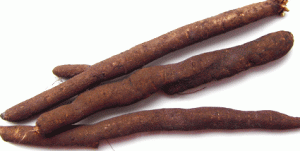The far back corner of our local vegetable market is full of bins containing strange, dirty lumps. Most are soil-crusted; all are oddly shaped, twisted, and unlovely. It’s not a popular section of the store. Occasionally an old woman hobbles back and picks out a few of these odd dirty objects to add to her basket, but most people stick to the well-lit front aisle where the bananas sparkle in the sunlight.
Fate would change all of this. Last Saturday morning when I was out jogging, a cookbook in a shop window caught my eye and I actually stopped running to take a look. Some time later, i.e. after the sun had come up, I dragged my sleepy-eyed hubby bunny into the bookstore so he could buy it for me.
 Genius! A cook-/reference-book for old veg varieties that is utterly gorgeous and brimming with very simple, modern recipes that suggest that, yes, those old root vegetable varieties that haven’t been regularly consumed since wartime Germany can be sexy, once the clumps of dirt have been washed off.
Genius! A cook-/reference-book for old veg varieties that is utterly gorgeous and brimming with very simple, modern recipes that suggest that, yes, those old root vegetable varieties that haven’t been regularly consumed since wartime Germany can be sexy, once the clumps of dirt have been washed off.
 (Old Vegetable Varieties, Cooked New(-ly).)
(Old Vegetable Varieties, Cooked New(-ly).)
So yesterday, armed with my field guide to underground edibles and a reusable shopping bag, my spouse and I ventured bravely into the back corner of the vegetable store. We were alone back there. It was dark. And cold. And it smelled like dirt. And most of the still-soil-crusted lumps were indistinguishable from one another. But we did not lose heart, faithful reader! Pastinaken! Petersilienwurzel! Rüben! Schwarzwurzeln! Süßkartoffeln! violette Möhren! We selected our dirty lumps with unflagging courage!
When we got to the counter, the cashier scratched his head in confusion. Wissen Sie, was das ist? Das ist ja keine Banana. No, trained vegetable professional, that is not a banana.
(These are Schwarzwurzeln – literally, black roots. As English translations, the dictionary suggests salsify, black salsify, comfrey root, scorzonera (bot.), and viper’s grass. Any of those sound familiar to anyone? …no, me neither.)
But they clean up nicely, don’t they, the little lumps? And after 45 minutes of oven roasting with olive oil, sea salt, rosemary, and thyme, they were DELICIOUS, and yes that’s delicious intentionally spelled in all-caps to emphasize the deliciousness, and no I’m not yelling DELICIOUS in your face, although I’m tempted to, because yes, they were that yummy.
In the medieval tradition of apophatic theology, God was “the Being beyond Being”. I would like to submit to the world that these homely brown lumps, done right, could be described as the Vegetable beyond Vegetables, the ÜberVeg. So cast aside your limp heads of iceberg for once and for all, friends, and experience the revelation that is the humble, earth-crusted edible root.
That gives hope to the rest of us unlovely little lumps, doesn’t it? Here’s to reveling in all of our earth-crusted glory, today and forever. May we learn to taste and see God where she is to be found, whether in bread & wine or in a roasted knobby edible root.
Amen.



I am really looking forward to your inquiry on beets and turnips, because, despite being a native german, I never really tried all of them, mostly because I don’t know what to do with them besides making soup – and there is a limited capacity for turnip-and-potato-soup. 😉
Schwarzwurzeln are also called “poor man’s asparagus”, might be the reason no one wants to be seen with it nowadays. 😉
That’s a great looking cookbook. I’d love to have some kinda book to identify different squashes!
What I want to know is….how did I miss this bookstore when I was in Munich visiting?! Love the post and love the poster! 🙂
Schwarzwurzeln are traditional vegetables and they came out of fashion because one gets dirty and sticky fingers peeling them, so be careful to wash your hands in lemon juice afterwards or wear gloves. They are delicious prepared like asparagus with a nice sauce mousseline or hollandaise.
They also taste nicely mixed with carrots and “Pastinaken”